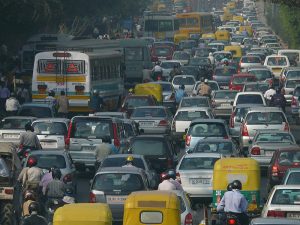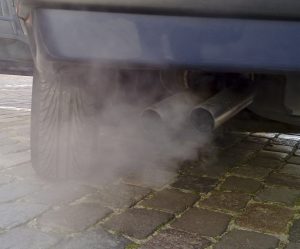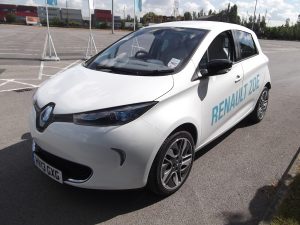26
Jonathan Kershaw, Coventry University, UK
With projected increased urban populations in the future, developing a sustainable urban mobility assumes a great importance. However, given the impact that the car has had socially and culturally, what are the prospects for a sustainable urban automobility?
At the root of this question is the notion that the private car isn’t going to go away, at least not any time soon. The autopoieisis of the system of automobility (Urry, 2004) has ingrained the car upon our landscape. For many, the car is also too convenient, too aspirational, and too desirable. Much has been written about the costs and impracticalities of low carbon vehicles, and the car; although the cultural and semiotic nature of the car means that it has always been more than just a means of transport, less is known about how socio-cultural mores regarding the car might impact upon the transition to low carbon motoring.
How we ‘consume’ the car as icon, avatar, cultural artefact and experience – whether as driver, passenger or pedestrian – is crucial in effecting a transition to a low carbon automobility because cars carry more than people; indeed it is precisely because they carry people that they can transcend their instrumental use, carrying experiences, meanings and feelings too (e.g. Sachs, 1992; Miller, 2001; Sheller, 2004; Steg, 2005) and, in doing so, cars can become more than just transport.
Yet, as Urry notes, the number of cars on the road globally is such that automobility can be regarded as “a modern day Leviathan” (2008: 265), at once threatening to consume us as “urban space … tends to be sliced up, degraded and destroyed” (Lefebvre, 1991: 359, in Sheller & Urry, 2000: 742) yet at the same time hinting at the hold that the allure of the motor car has over society. However, there is more to Urry’s Leviathan than traffic congestion, something else that ‘drives’ my research.

Such has been the ‘lock-in’ of the internal combustion engine (Black, 2006; Ivory & Genus, 2010), increasing emissions and air pollution is necessarily concomitant with a rise in automobility. The private car uses more energy and emits more greenhouse gases per passenger-kilometre than any other surface transport mode (Khan Ribeiro et al, 2007) and, in Europe, where road transport not only accounts for almost 75% of transport emission (EC, 2011a), it is claimed that the car alone is responsible for 12% of all CO2 emissions there (EC, 2011b).
Of course, there is more to transport emissions than CO2. We’ve all seen pictures of the Los Angeles haze and the Beijing smog and, from my own experience of walking down Oxford Road in Manchester, reportedly Europe’s busiest bus route, the localised air pollution from the petrol and/or diesel internal combustion engine (ICE) can be almost tangible. The transition from the horse to the automobile which may have resulted in a welcome reduction in the amount of dust and flies (Zierer, 1922) ultimately replaced one form of localised airborne irritants for another. Road transport vehicles are regarded as a major source of what are known as ‘criteria’ pollutants, such as carbon monoxide (CO), particulate matter (PM), nitrogen dioxide (NO2) and ozone (O3), with emissions of sulphur oxides (SOx) and volatile organic compounds (VOCs) also attributed to road transport, especially diesel vehicles (Lave and Griffin, 2008; Holmén and Niemeier, 2003).

Crucial though CO2 emissions reduction undoubtedly is, the recent pursuit of low carbon vehicles has seemingly been made with little regard for these criteria pollutants, with – in the UK – vehicle excise duty-based incentives having been based upon official CO2 emissions EU figures collated from the NEDC (New European Driving Cycle) test (UN, 2011: 87-89; UK Government, 2014) resulting in increasing numbers of new diesel powered cars hitting the roads; indeed, half of new cars sold in the UK in 2014 were diesels, compared to their comprising of a third of the UK new car market a decade earlier (SMMT, 2015). Many motorists who thought they were doing the right thing in buying diesel cars emitting less CO2/km than their petrol counterparts now find themselves contributing to diminishing local air quality. A roll-out of hybrid and electric cars (or EVs) can do much to ameliorate this problem, although some critics say that they will still contribute to traffic congestion.
Autonomous automobility is a possibility in an urban future, with software companies such as Apple and Google exploring the prospect of ‘driverless’ cars, as are conventional automobile manufacturers. These cars can address inequalities of automobility in providing access to those disenfranchised, such as the elderly or disabled. They are also touted as a solution to congestion, though effecting this will necessitate the installation of all manner of surveillance technology (Urry, 2008) potentially constituting an “Orwellian panopticon” (ibid: 261) which could have implications for privacy and the ‘freedom’ that the car traditionally affords.
Urry duly notes that an autonomous automobility and its supporting infrastructure will change our relationship with the car. Similarly, adopting a low carbon automobility in a more conventional, privatised mien may provide the opportunity for the car to be ‘consumed’ differently. EVs provide a different experience of, and meaning to, how we present and perform – or affect – individual automobilities, and I wonder about the degree to which we are culturally ready to change ‘how’ we go from here. Can we change? Do we even want to? As a geographer and car enthusiast with an awareness of automotive environmental impacts, this is something which interests me greatly.

A sustainable urban automobility may be possible in the future. However, such is the autopoieitic nature of the system of automobility (Urry, 2004), who’s to say that the solution to the travails of urban automobility won’t be achieved very much on the car’s terms?
References
Black, E. (2006) Internal Combustion: How Corporations and Governments Addicted the World to Oil and Derailed the Alternatives. St Martins Press. New York.
Ivory, C. & Genus, A. (2010) Symbolic consumption, signification and the ‘lockout’ of electric cars, 1885-1914. Business History 52(7): 1107-1122.
EC (2011a) Reducing emissions from transport. http://ec.europa.eu/clima/policies/transport/index_en.htm. Accessed 25/05/15.
EC (2011b) (2014) Reducing CO2 emissions from passenger cars. http://ec.europa.eu/clima/policies/transport/vehicles/cars/index_en.htm. Accessed 25/05/15.
Holmén, B.A. & Niemeier, D.A. (2003) Air quality. In Henscher, D.A. & Button K.J. (Eds.) Handbook of Transport and the Environment. Elsevier. Oxford. pp 61-79.
Khan Ribeiro, S., Kobayashi, S., Beuthe, M., Gasca, J., Green, D., Lee, D.S., Muromachi, Y., Newton, P.J., Plotkin, S., Sperling, D, Wit, R. & Zhou, P.J. (2007) Transport and its infrastructure. In Metz, B., Davidson, O.R., Bosch, P.R., Dave, R. & Meyer, L.A. (Eds.) Climate Change 2007: Mitigation. Contribution of Working Group III to the Fourth Assessment Report of the Intergovernmental Panel on Climate Change. Cambridge University Press. Cambridge. pp 323-385.
Lave, L.B. & Griffin, W.M. (2008) The economic and environmental footprints of transportation. In Kutz, M. (Ed.) Environmentally Conscious Transportation. Wiley. Hoboken NJ. pp 1-13.
Lefebvre, H. (1991) The Production of Space. Blackwell Publishing Ltd. Oxford.
Miller, D. (Ed.) (2001) Car Cultures. Berg. Oxford.
Sachs, W. (1992) For the Love of the Automobile: Looking Back into the History of our Desires. University of California Press. Berkeley; Oxford.
Sheller, M. (2004) Automotive emotions: feeling the car. Theory, Culture and Society 21(4/5): 221-242.
Sheller, M. & Urry, J. (2000) The city and the car. International Journal of Urban and Regional Research 24(4): 737-757.
SMMT (Society of Motor Manufacturers and Traders) (2015) Motor Industry Facts 2015. http://www.smmt.co.uk/wp-content/uploads/sites/2/100049_SMMT-Facts-Guide-2015.pdf . Accessed 24/05/15.
Steg, L. (2005) Car use: lust and must. Instrumental, symbolic and affective motives for car use. Transportation Research Part A: Policy and Practice 39(2/3): 147-162.
UK Government (2014a) Vehicle tax rate tables. https://www.gov.uk/vehicle-tax-rate-tables . Accessed 27/05/14.
UN (United Nations) (2011) Uniform provisions concerning the approval of vehicle with regard to the emission of pollutants according to engine fuel requirements. http://www.unece.org/fileadmin/DAM/trans/main/wp29/wp29regs/r083r4e.pdf . Accessed 09/04/14.
Urry, J. (2004) The ‘system’ of automobility. Theory, Culture and Society 21(4/5): 25-39.
Urry, J. (2008) Climate change, travel and complex futures. The British Journal of Sociology 59(2): 261-279.
Zierer, C.M. (1922) Geography and the automobile. The Journal of Geography 21: 190-198.
Author Biography
 Jonathan Kershaw is a PhD research student based at the Centre for Business in Society (CBiS) at Coventry University, researching the socio-cultural ‘consumption’ of the car and how our relationship with the car might impact upon the uptake of low carbon vehicles by exploring the notions of affect and non-representational theory. A self confessed ‘treehugging petrolhead’, he is interested in low carbon vehicles and also in wider ethical, environmental and sustainability issues beyond the car. Interested in all aspects of motoring, Jonathan is a member of the Institute of Advanced Motorists and of the Triumph Dolomite Club.
Jonathan Kershaw is a PhD research student based at the Centre for Business in Society (CBiS) at Coventry University, researching the socio-cultural ‘consumption’ of the car and how our relationship with the car might impact upon the uptake of low carbon vehicles by exploring the notions of affect and non-representational theory. A self confessed ‘treehugging petrolhead’, he is interested in low carbon vehicles and also in wider ethical, environmental and sustainability issues beyond the car. Interested in all aspects of motoring, Jonathan is a member of the Institute of Advanced Motorists and of the Triumph Dolomite Club.
Contact Details:
Email: kershaw3@uni.coventry.ac.uk;
Twitter: @jeckythump
